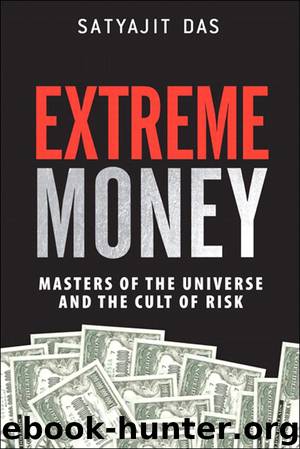Extreme Money: Masters of the Universe and the Cult of Risk (Frank Feng's Library) by Satyajit Das

Author:Satyajit Das
Language: eng
Format: epub
Publisher: FT Press
Published: 2011-06-14T16:00:00+00:00
Risk Is Our Business
Cornelius Van der Starr founded AIG in 1919 in Shanghai, China. Under Maurice R. “Hank” Greenberg, Starr’s successor and CEO for 37 years, AIG became one of the largest underwriters of commercial and industrial insurance in the world, with $110 billion in revenues and $1 trillion in assets.
AIG’s marketing boasted that “the biggest risk is not taking one.” In September 2008, AIG’s poor risk management required a government rescue, with an initial $85 billion line of credit.
AIG’s problems related to AIG Financial Products (FP), a specialist derivative trading operation, the brainchild of former Drexel Burnham Lambert trader Howard Sosin. Restricted by Drexel’s low credit ratings, he saw the opportunity to create a derivatives business using AIG’s AAA credit rating and large balance sheet.
Fortuitously, Greenberg was looking to expand outside insurance at the time. Aware of the risk of the complex joint venture, Sosin negotiated the arrangements carefully. As his legal advisor put it: “let us plan your divorce while we’re planning your marriage.”15 Sosin got autonomy and a generous financial share of the business. AIG got 65 percent of earnings, while Sosin’s team received 35 percent.
Initially, FP focused on traditional derivatives, interest rate, and currency swaps. FP focused on long-dated transactions, up to 30 years, taking advantage of AIG’s AAA status. In July 1987, FP completed a $1 billion swap with the Republic of Italy, ten times a typical trade at the time, earning $3 million. In its first 6 months of operation, FP made around $60 million, establishing itself as the go-to shop for complex, long-dated derivatives.
FP became a beautiful money-making engine, contributing more than $5 billion to AIG’s pretax income. Sosin was well rewarded. Even a company lawyer received a $25 million bonus at the end of 1 year.
The autocratic Greenberg mistrusted the equally autocratic Sosin’s independence. Sosin resented Greenberg’s interference in operations that AIG did not understand. The central issue was the calculation of FP’s profits.
Derivative transactions are accounted for on a mark-to-market (MtM) basis—the current market price of the instrument. MtM accounting allows earnings to be recognized up front, even if the deal has a life of 30 years. As derivatives trade privately, market prices for specific transactions are not directly available. Derivative profits are mark-to-model or mark-to-myself rather than mark-to-market. Model variations and small differences in input can result in large changes in values for some products. Investment blogger Nicholas Vardy compared mathematical models to bikinis: “What they reveal is suggestive; but what they conceal is vital.”16
As there is no real market for long-term, complex deals, Sosin and FP were the market. Trading was illiquid. In the words of the trader: “I would take your time and have your cup of coffee.”17 FP’s deals created the quotes against which their transactions were valued. FP and Sosin received theoretical profits up front based on models while AIG remained at risk over the life of the transaction. FP had access to AIG’s credit ratings and capital, largely rent-free. Sosin and FP had powerful incentives to chase short-term profits, leaving AIG with potential future losses.
Download
This site does not store any files on its server. We only index and link to content provided by other sites. Please contact the content providers to delete copyright contents if any and email us, we'll remove relevant links or contents immediately.
Rich Dad Poor Dad by Robert T. Kiyosaki(6513)
Pioneering Portfolio Management by David F. Swensen(6253)
How To Win Friends and Influence People by Dale Carnegie(4470)
The Money Culture by Michael Lewis(4132)
The Dhandho Investor by Mohnish Pabrai(3722)
The Wisdom of Finance by Mihir Desai(3693)
Liar's Poker by Michael Lewis(3413)
Fooled by Randomness: The Hidden Role of Chance in Life and in the Markets by Nassim Nicholas Taleb(3080)
The ONE Thing by Gary Keller(3031)
The Intelligent Investor by Benjamin Graham Jason Zweig(3010)
Mastering Bitcoin: Programming the Open Blockchain by Andreas M. Antonopoulos(3010)
Rich Dad Poor Dad: What The Rich Teach Their Kids About Money - That The Poor And Middle Class Do Not! by Robert T. Kiyosaki(2929)
How to Day Trade for a Living: Tools, Tactics, Money Management, Discipline and Trading Psychology by Andrew Aziz(2924)
Investing For Dummies by Eric Tyson(2920)
How to Win Friends and Influence People by Dale Carnegie(2883)
The Psychology of Money by Morgan Housel(2799)
Market Wizards by Jack D. Schwager(2669)
Zero Hour by Harry S. Dent Jr. & Andrew Pancholi(2628)
How to Pay Zero Taxes, 2018 by Jeff A. Schnepper(2621)
